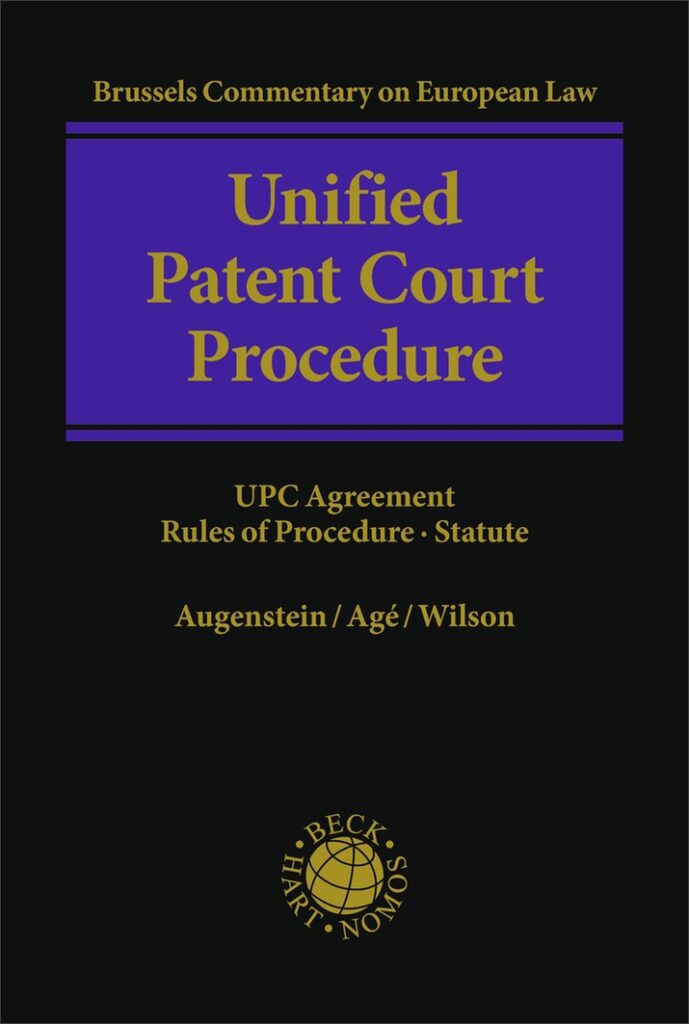Washtower v. BEGA-Gruppe, UPC LD The Hague, The Netherlands, 11 September 2025, Case no. UPC_CFI_479/2025, annotation by Honorary Member and former EPLAW President Prof. Willem Hoyng, HOYNG ROKH MONEGIER
1. This decision is interesting for several reasons, among which are:
a. A very neat invention by an SME. Everybody knows that washing machines are not only heavy but also vibrate during washing, and if placed in cabinets exert such forces on the walls that they easily destroy the cabinet. The invention provides the solution.
b. A very detailed and convincing reasoning with respect to novelty and inventive step.
c. An interesting decision regarding the influence of a Board of Appeal decision in PI proceedings.
d. Interesting considerations regarding the doctrine of equivalence in the UPC.
2. With respect to the last two points, a few short observations.
The Board of Appeal
3. In PI proceedings, the Court has to decide, with respect to a defense based on the invalidity of the patent whether or not (on the basis of the arguments put forward by the defendant) it is more likely than not that the patent is invalid.
4. In considerations 5 and 5.1.1, the Court states:
5. Defendants contend that the L-shaped retaining member as introduced into claim 1 during the examination phase of the patent constitutes an impermissible amendment, since it introduced subject-matter that extends beyond the content of the application as originally filed.
5.1.1. This objection mirrors the position previously taken by the Examination Division of the EPO, which relied on Article 123(2) EPC to refuse the grant of the patent. Applicants appealed the decision, and the Technical Board of Appeal of the EPO reversed the Examination Division’s decision. Already from this, it can be deduced that it is more likely than not that the patent will not be found to contain added matter. In as far as necessary, the Court finds as follows.
5. In this case, the defendants used the same arguments on the basis of which the Examining Division refused to grant the patent because of added subject-matter (Art. 123(2) EPC). The argument was based on so-called intermediate generalization. The L-shaped member was, according to the Examining Division and defendants, only disclosed as fixed to the underside of the cover plate, and they argued that there was a structural link between the two. In other words, there was no disclosure of a stand-alone L-shaped retaining member.
6. The Board of Appeal reversed the decision of the Examining Division, and the Court held that in PI proceedings this is enough to decide that it is not more likely than not that the patent is invalid. Nevertheless, the Court itself also motivated that decision, in my opinion convincingly.
7. I think that if the Board of Appeal has decided an invalidity argument in favor of the patentee, and the defendant raises in PI proceedings the same argument with the same reasoning, the Court is right that, for PI purposes, that decision should be followed unless, I would add, the defendant shows that the decision of the Board of Appeal is manifestly wrong.
8. In revocation proceedings, I think that if the claimant raises the same arguments as were raised at the Board of Appeal, the situation is somewhat different. The decision of the Board of Appeal should also, in principle, be followed, but the claimant can show that and why the decision is wrong. On the one hand, it is, from a point of legal certainty, desirable if a Board of Appeal and a Court come to the same decision. On the other hand it is the Court’s judgment which should prevail.
9. In my opinion, such a presumption that the decision of the Board of Appeal (given the same facts and arguments) is the right one is not justified with respect to decisions of the Opposition Division, which are clearly decisions of an administrative body. The Court will certainly take notice, but a presumption that the decision is right would go too far.
Equivalence
10. The second point I want to address is the decision about equivalence. I think that everybody will agree that, whatever theory you would use, there is no doubt that this case is a classic example of infringement by equivalence. The moment you apply the teaching of the Protocol (including Art. 2) and read that a strict literal interpretation of the claim is not how a claim should be interpreted, you will find infringement in this case, whatever equivalence theory you apply.
11. More interestingly, the Court comes to the same conclusion after applying a Dutch equivalence test, which is probably one of the hardest tests among the UPC countries for finding infringement by equivalence. The test was also used by the parties who both knew that the The Hague Division had already used that test in Plant-e v. Arkyne.
12. The Court justifies this application as follows:
8.1.22. Both parties referred to the test for equivalence adopted in Plant-e v. Arkyne. This test entails that a variation is equivalent to an element specified in the claim if the following four questions are answered in the affirmative.
1) Technical equivalence: does the variation solve (essentially) the same problem that the patented invention solves and perform (essentially) the same function in this context?
2) Fair protection for the patentee: Is extending the protection of the claim to the equivalent proportionate to a fair protection for the patentee?
3) Reasonable legal certainty for third parties: does the skilled person understand from the patent that the scope of the invention is broader than what is claimed literally?
4) Is the allegedly infringing product novel and inventive over the prior art?
As a preliminary observation, the Court points out that a harmonised approach within the UPC is certainly desirable, inspired on the doctrines of equivalence applied across UPC Contracting Member States which all share a common foundation. In particular, the bottom line is that a finding of equivalent patent infringement is excluded where there is no technical-functional equivalence — meaning the substituted means do not perform essentially the same function to achieve essentially the same result. Or, in the positive, finding of equivalent patent infringement always requires that the variant performs essentially the same function as the element recited in the claim, with essentially the same result. The same applies to the assumption that protection cannot extend to what is not new or inventive over the prior art. Similarly, legal certainty for third parties and a fair protection for the patentee are mentioned in Art. 1 of the Protocol on the interpretation of Art. 69 EPC and usually return in the doctrines of equivalence in some way or form as developed in the case law of the UPC Contracting Member States. In view of the above and in the absence of a decision by the Court of Appeal and given that both parties referred to this test without proposing or even debating an alternative, the Court sees no reason to deviate from the test it applied in Plant-e v. Arkyne. The Court will therefore now answer these questions.
13. I have to grant the Court that, until now, the Court of Appeal has not given guidelines on how to apply the doctrine of equivalence but it went a bit too far in pretending that this test resembles what is in fact applied in other UPC countries. In fact, the Court realizes this also by using rather vague language:
Similarly, legal certainty for third parties and a fair protection for the patentee are mentioned in Art. 1 of the Protocol on the interpretation of Art. 69 EPC and usually return in the doctrines of equivalence in some way or form as developed in the case law of the UPC Contracting Member States. [emphasis: Ho]
I have not seen in any UPC country, with respect to the doctrine of equivalence, an extra standalone requirement concerning the “certainty for third parties”.
14. It is also good to mention that the test, for the first time applied by the Dutch Court of Appeal, has been accepted by the Dutch Supreme Court as not violating Art. 69 EPC and the Protocol. However, the Supreme Court has certainly not ruled that this is the test that has to be applied in the Netherlands. In the past, the Supreme Court has also accepted the “means, way, function” test and the “insubstantial differences” test and has not given any indication that these tests are no longer valid.
15. The problem with the Dutch test, in my opinion (apart from the fact that none of the UPC countries use it) is that in practice a court can almost always reach the result it wants to achieve by referring to the fair protection for the patentee or the legal certainty for third parties (points 2 and 3 of the test). In other words, it is a test that gives hardly any guidance to the parties and makes the outcome too unpredictable. The Court is right that most countries require that the equivalent means perform essentially the same function (“solve essentially the same problem”) with essentially the same result.
16. I also agree that these two requirements are not sufficient to accept equivalence. If this essentially same result is reached in a different way, then indeed I do not think that there is infringement. Therefore, we should also require (as in the US) that the result is reached in essentially the same way.
17. In my opinion, if a means performs the same function in essentially the same way with essentially the same result, it is, in general, hard to imagine why it would not be fair to protect the patentee. The equivalent means will then realize, in substantially the same way, the inventive result. It is fair that the patentee, in such a case, will be able to recoup the investments made in conceiving the invention, as well as realize the extra profit from having an exclusive position thanks to his patent.
18. When we talk about the reasonable (and thus not absolute) certainty for third parties, we are in my opinion referring to a third party who is assisted by somebody who has experience with patents. A company (private individuals cannot infringe) that enters agreements, has to file its annual statements and pays taxes will turn to advisors familiar with that subject (if not present within the company). The same is true if it wants to launch a new product. Accordingly, third party refers to somebody assisted by a patent attorney.
19. No (capable) patent attorney will advise a client that they can safely sell in a situation where a means differing from a claimed feature performs essentially the same function in essentially the same way with essentially the same result. Of course, if he or she sees that the alleged equivalent means was known in the prior art or was not inventive at the priority date, he or she will advise to go ahead (point 4 of the Dutch test).
20. I therefore do not see any further necessity to ask the question if finding infringement under these circumstances is fair and does not violate the certainty of third parties.
21. These general requirements can easily lead to undesirable judgments, especially because of the general condition concerning the certainty for third parties. However, also the second general condition (“is protection fair?”) can lead to decisions such as: it is not fair to grant protection because the patentee could easily have foreseen the equivalent but did not literally cover it (a holding of the Dutch Court of Appeal in Van Bentum v. Kool, which was reversed at the time by the Supreme Court).
22. To judge 10 years or so after the fact that the patentee could have foreseen the equivalent is already a difficult (hindsight) decision, but even if the patentee and his patent attorney could have seen it, what would be the justification for robbing him of protection and making his patent in practice without value if the “means, way, function” test is met? How is the certainty for third parties affected if the third party knows that he is realizing the invention and there is nothing else which points to a deliberate choice of the patentee to limit the scope of protection, other than maybe that the patentee (his patent attorney) did a sloppy job in formulating the claim?
23. The third condition is much more dangerous because it is very easy to argue that if the claim says A, that the security for third parties is violated by holding that the third party should be able to understand that B is covered by the claim.
24. In this case, the Court did not accept such an argument because there were numerous reasons that such an argument would be obviously wrong. However, we have seen examples in Dutch case law in which this general “certainty” argument wipes out good inventions.
25. The Court of The Hague held in the Premetexed case, different from all major jurisdictions in Europe, that there was no infringement. The decision was corrected by the Court of Appeal applying the Dutch equivalence test, but in my view only because in other countries the courts had ruled that there was infringement. A further example was the water balloon case. This was, in my view, a clear case of infringement under the “function, way, result” test but infringement was denied by the Court of Appeal by invoking the certainty of third parties because of certain, for the scope of protection, irrelevant events during prosecution. I do not advocate that there cannot be exceptions to the general rule that there is infringement if the variant performs essentially the same function in essentially the same way with essentially the same result, but the exceptions should be specific and not vague.
26. As an example: if the patentee describes the equivalent means clearly in the description but does not claim them (disclosed but not claimed). Another example is if, in order to claim novelty or inventive step, the applicant restricts its claim and the equivalent means are no longer literally covered.
27. However, even then one has to be careful and look at the specific case.
I give the following example:
The invention is based on the idea of solving the problem that washing socks leads, for one reason or another, to the loss of one sock so that the pair is incomplete. The solution proposed in the patent is to attach the socks to each other before putting them in the washing machine. The patent gives, in the description, as example, having on the inside of the edge of the sock a strip of Velcro to attach the socks before washing. During prosecution a document is found which proposes attaching a pair of socks with a clip. The patentee restricts its patent to the example arguing that the advantage of his invention is that you do not need a separate piece such as a clip. In my view, the use of a press stud (which would have literally infringed the original claim) would still be an infringement under the doctrine of equivalence.
28. I sincerely hope that the Local Division in The Hague stops using the Dutch equivalence test and applies a test that is more universally accepted. Of course, as long as the application of the test does not lead to accidents such as those indicated above, which would lead to a bad reputation for the UPC, no wrong has been done.
29. More importantly, I hope that the Court of Appeal will not adopt the Dutch equivalence test for the reasons set out above.















